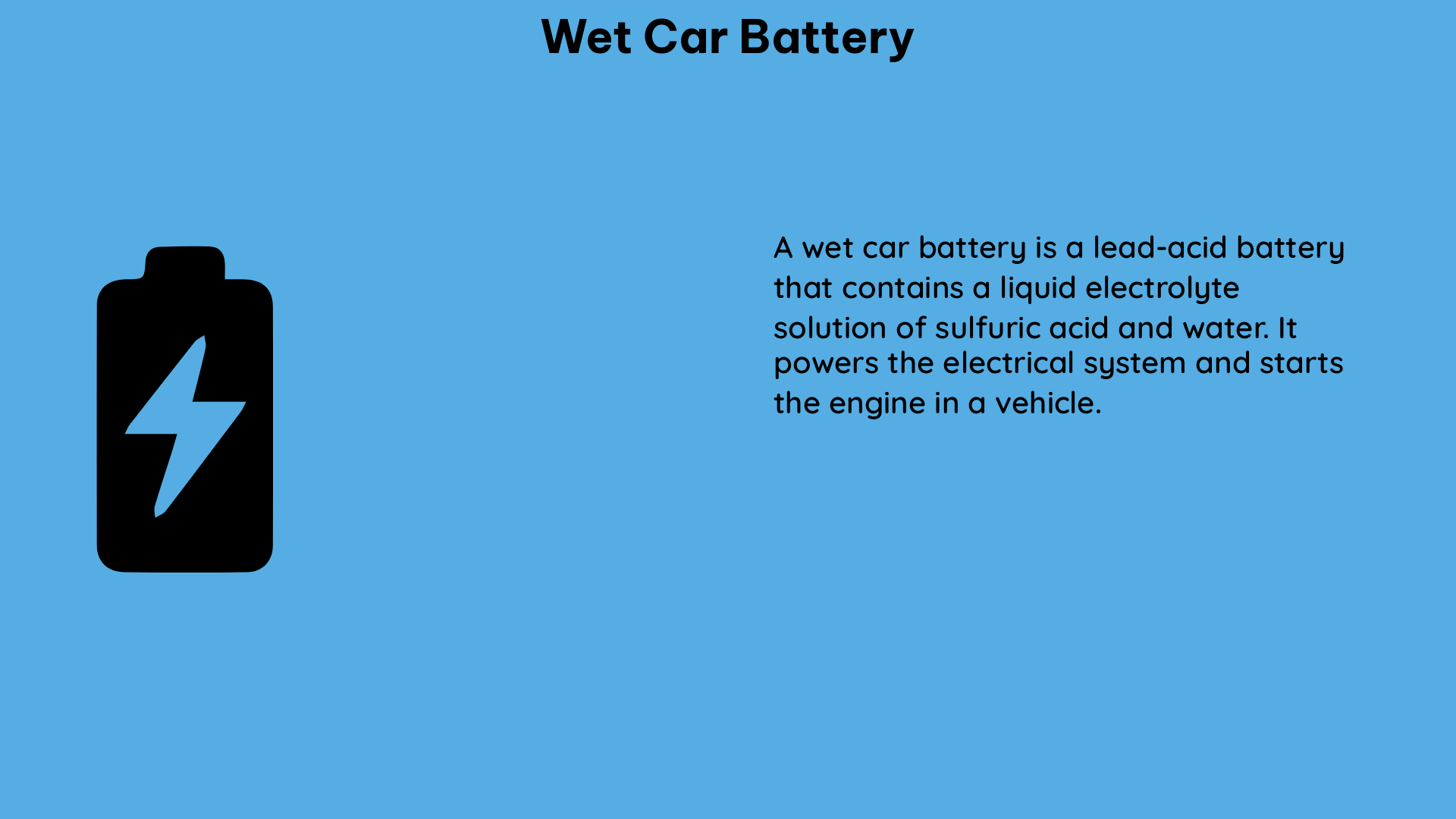A wet car battery, also known as a flooded lead-acid battery, is a type of rechargeable battery commonly used in traditional internal combustion engine vehicles. These batteries are characterized by their ability to provide high current output, making them essential for starting and powering the electrical systems of automobiles. In this comprehensive guide, we will delve into the technical specifications, measurement techniques, and testing procedures for wet car batteries, equipping you with the knowledge to maintain and troubleshoot these critical components.
Technical Specifications of Wet Car Batteries
Wet car batteries are typically 12-volt systems, although they can range from 6 to 12 volts depending on the battery’s design and purpose. The capacity of a wet car battery is measured in ampere-hours (Ah), which indicates how long the battery can supply a certain current. For example, a 50 Ah battery can supply 50 amperes for one hour or 25 amperes for two hours.
Another crucial specification is the cold cranking amps (CCA) rating, which reflects the battery’s ability to deliver a high current at low temperatures, typically 0°F (-18°C). A higher CCA rating means the battery can start the engine more easily in cold weather. The CCA rating for wet car batteries typically ranges from 300 to 1,000 amps, with higher-end batteries reaching up to 1,200 amps.
Measuring the State of Charge (SoC) of Wet Car Batteries

To determine the state of charge (SoC) of a wet car battery, two common methods are used: hydrometer and multimeter.
Hydrometer Method
A hydrometer is a tool that measures the specific gravity (SG) of the battery’s electrolyte. As the battery charges, the SG of the electrolyte increases, and as the battery discharges, the SG decreases. The SG readings can be used to estimate the SoC of the battery, as shown in the table below:
| SG Reading | State of Charge |
|---|---|
| 1.265-1.280 | 100% |
| 1.225-1.240 | 75% |
| 1.190-1.205 | 50% |
| 1.155-1.170 | 25% |
| 1.120-1.135 | 0% |
Multimeter Method
Alternatively, a multimeter can be used to measure the open-circuit voltage (OCV) of the battery. As the battery charges, the OCV increases, and as the battery discharges, the OCV decreases. The OCV readings can be used to estimate the SoC of the battery, as shown in the table below:
| OCV Reading | State of Charge |
|---|---|
| 12.8-13.0 V | 100% |
| 12.6-12.8 V | 75% |
| 12.4-12.6 V | 50% |
| 12.2-12.4 V | 25% |
| 12.0-12.2 V | 0% |
It’s important to note that measuring the SoC of a wet car battery is not a straightforward task, as it can be influenced by factors such as temperature, age, and battery type. Therefore, it is essential to follow the manufacturer’s instructions and recommendations when measuring the SoC of a wet car battery.
Testing the Health and Capacity of Wet Car Batteries
In addition to measuring the SoC, it is also important to test the overall health and capacity of a wet car battery. This can be done using specialized testing devices and methods, such as impedance spectroscopy.
Impedance Spectroscopy
Impedance spectroscopy, using the Spectro™ complex modeling method, can measure the SoC of a battery independently of voltage. This method is particularly useful in automotive manufacturing and load leveling systems, as it can identify a low-charge battery from one with a genuine defect. This is important in situations where a parasitic load, such as opening a car door, can falsify voltage-based SoC measurements.
Conventional Wet Cell Battery Testing
When testing a conventional wet cell battery, a measuring device that can only measure the state of charge of the battery can be used. In an ideal case, an open-circuit voltage of about 12.8 V is measured with a multimeter. If the voltage falls below 12.4 V, the battery should be recharged as soon as possible to prevent sulfation.
Start-Stop Battery Testing
When testing a start-stop battery, both the state of charge (SoC) and the state of health (SoH) of the battery are important. A complex test procedure is required to assess the SoH, which takes into account factors such as the cold start capability (CCA), the residual capacity (Ah), and the charge acceptance (CA).
Regardless of the battery type, it is crucial to follow the correct testing procedures and use the right testing devices to ensure accurate and reliable results. Proper testing can help identify potential issues, prevent sudden failures, and extend the lifespan of your wet car battery.
Conclusion
Wet car batteries are a critical component of traditional internal combustion engine vehicles, providing the necessary power for starting and powering the electrical systems. Understanding the technical specifications, measurement techniques, and testing procedures for these batteries is essential for maintaining their performance and longevity.
By following the guidelines outlined in this comprehensive guide, you can effectively measure the state of charge, assess the overall health, and troubleshoot any issues with your wet car battery. Remember to always consult the manufacturer’s instructions and use the appropriate testing devices to ensure accurate and reliable results.
References:
- Battery University, “How to Measure State-of-charge”, https://batteryuniversity.com/article/bu-903-how-to-measure-state-of-charge
- Reddit, “Why do traditional cars lack any decent ability to warn the driver that the battery is low or about to die?”, https://www.reddit.com/r/explainlikeimfive/comments/jz2tg3/eli5_why_do_traditional_cars_lack_any_decent/
- Varta Automotive, “Car battery testing instructions”, https://batteryworld.varta-automotive.com/en-gb/battery-test-car

The lambdageeks.com Core SME Team is a group of experienced subject matter experts from diverse scientific and technical fields including Physics, Chemistry, Technology,Electronics & Electrical Engineering, Automotive, Mechanical Engineering. Our team collaborates to create high-quality, well-researched articles on a wide range of science and technology topics for the lambdageeks.com website.
All Our Senior SME are having more than 7 Years of experience in the respective fields . They are either Working Industry Professionals or assocaited With different Universities. Refer Our Authors Page to get to know About our Core SMEs.